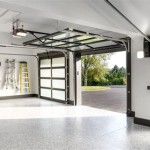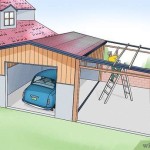How To Make a Homemade Garage Door
Constructing a garage door from scratch is a significant undertaking that requires careful planning, precise execution, and a thorough understanding of structural integrity and safety considerations. While commercially manufactured garage doors offer convenience and are engineered to meet specific performance standards, building a homemade garage door can provide customization options and potentially reduce costs for those with the necessary skills and resources. This article outlines the essential steps involved in building a functional and safe garage door, focusing on common design choices, material selection, and critical safety protocols.
Before embarking on this project, it is imperative to assess one's aptitude and resources realistically. Carpentry skills, familiarity with power tools, and a comfortable working environment are crucial. Furthermore, adherence to local building codes and regulations is non-negotiable. Consult with local authorities to determine permit requirements and ensure compliance with safety standards before commencing construction.
Planning and Design
The initial phase involves meticulous planning and design. The dimensions of the garage door opening must be accurately measured. Precise measurements are essential to ensure the finished door fits snugly within the opening, preventing drafts and minimizing the risk of operational issues. Consider the desired style and operation method. Common options include sectional doors (composed of horizontal panels that rise vertically), side-hinged doors (similar to traditional doors), and roll-up doors (which coil into a drum above the opening).
Sectional doors are the most prevalent type due to their space-saving design and ease of automation. However, they require more complex hardware and construction compared to side-hinged doors. Side-hinged doors offer a simpler design but require sufficient swing space in front of the garage. Roll-up doors, while efficient in space utilization, demand specialized hardware and a robust support structure.
A detailed blueprint or sketch of the garage door is essential. This drawing should include precise dimensions, material specifications, and the location of all hardware components. The design should account for the weight of the door and the stresses it will endure during operation. This is particularly crucial for sectional and roll-up doors, where counterbalance systems are necessary to facilitate smooth and safe operation.
The design phase must also address insulation. Garage doors are often a significant source of heat loss or gain, affecting the overall energy efficiency of the building. Incorporating insulation into the door's construction can significantly reduce energy costs and improve comfort within the garage. Rigid foam insulation boards, such as expanded polystyrene (EPS) or polyurethane, are commonly used for this purpose. The thickness of the insulation should be determined based on the desired R-value (thermal resistance). Consider the added weight of the insulation when calculating the required strength of the door frame and hardware.
Material Selection and Construction
The selection of appropriate materials is critical to the durability, functionality, and aesthetic appeal of the garage door. Wood, steel, and aluminum are common choices for the door frame and panels. Wood offers a classic aesthetic and is relatively easy to work with, but it requires regular maintenance to prevent rot and warping. Steel provides superior strength and durability but is susceptible to rust if not properly treated. Aluminum is lightweight and corrosion-resistant but may not be as strong as steel.
For the frame, pressure-treated lumber is highly recommended, especially for sections that will be in direct contact with the ground or exposed to moisture. Pressure treating protects the wood from decay and insect infestation, extending its lifespan. Steel framing, while more expensive, offers superior strength and longevity, particularly in harsh climates.
The door panels can be constructed from plywood, composite wood, or metal sheets. Plywood is a cost-effective option for wooden doors but should be exterior-grade to withstand the elements. Composite wood, such as oriented strand board (OSB) or medium-density fiberboard (MDF), offers improved water resistance compared to standard plywood. Metal sheets, typically steel or aluminum, provide a durable and low-maintenance surface. When using metal sheets, ensure they are properly primed and painted to prevent corrosion.
The construction process involves cutting the chosen materials to the specified dimensions and assembling the door frame. Accurate cuts and tight joints are essential for a structurally sound door. Use appropriate fasteners, such as screws or bolts, to secure the frame members together. Apply wood glue to the joints for added strength and stability when using wood.
Once the frame is assembled, the door panels can be attached. Ensure the panels are properly aligned and securely fastened to the frame. When using insulation, cut the insulation boards to fit snugly between the frame members and secure them with adhesive or mechanical fasteners. Cover the insulation with an interior panel to protect it from damage and improve the aesthetic appearance of the door.
For sectional doors, hinges and rollers must be installed to allow the panels to move smoothly along the tracks. The hinges should be heavy-duty and designed specifically for garage doors. The rollers should be lubricated to ensure smooth operation. The hinges and rollers must be positioned precisely to ensure the door sections align correctly and move without binding.
For side-hinged doors, heavy-duty hinges are also essential. The hinges should be capable of supporting the weight of the door and withstanding the stresses of repeated opening and closing. Install a secure latching mechanism to keep the doors closed and prevent unauthorized entry.
Hardware and Safety Considerations
The selection and installation of appropriate hardware are crucial for the safe and reliable operation of the garage door. This includes tracks, rollers, hinges, springs, cables, and locking mechanisms. The hardware must be rated for the weight and size of the door. Using undersized or improperly installed hardware can lead to premature failure and potentially dangerous situations.
For sectional doors, the track system guides the door as it moves up and down. The tracks must be securely mounted to the garage walls and ceiling. The rollers should fit snugly within the tracks and move smoothly without binding. The track system must be aligned properly to ensure the door operates smoothly and without excessive friction.
Counterbalance systems, such as torsion springs or extension springs, are essential for sectional doors to offset the weight of the door and make it easier to open and close. Torsion springs are generally preferred due to their longer lifespan and smoother operation. However, they require specialized tools and knowledge to install and adjust. Extension springs are easier to install but may not last as long and can be more dangerous if they break.
Garage door springs store a tremendous amount of energy and can cause serious injury or death if mishandled. It is strongly recommended to hire a qualified professional to install and adjust garage door springs. Attempting to work with garage door springs without proper training and equipment is extremely risky.
Safety cables are essential for extension spring systems to prevent the springs from flying off and causing injury if they break. The safety cables should be routed through the springs and securely attached to the garage wall or ceiling.
A secure locking mechanism is necessary to prevent unauthorized entry. Install a deadbolt lock or slide bolt to secure the door from the inside. Consider adding an exterior handle with a key lock for added security. Ensure the locking mechanism is robust and resistant to tampering.
Garage door openers can automate the operation of the door, providing convenience and security. When installing a garage door opener, follow the manufacturer's instructions carefully. The opener should include safety features such as an automatic reversing system that stops and reverses the door if it encounters an obstruction. Install photo eyes near the bottom of the door opening to detect obstructions and prevent the door from closing on people or objects. Test the safety features regularly to ensure they are functioning properly.
Regular maintenance is essential to ensure the safe and reliable operation of the garage door. Lubricate the hinges, rollers, and tracks regularly. Inspect the springs, cables, and hardware for signs of wear or damage. Replace any worn or damaged components promptly. Clean the door panels to prevent dirt and debris from accumulating. Inspect the weather stripping around the door to ensure it is providing a proper seal. Address any issues promptly to prevent them from escalating into more significant problems.
Building a garage door is a challenging but rewarding project for those with the necessary skills and resources. By following these instructions carefully and adhering to all safety precautions, one can successfully construct a functional and aesthetically pleasing garage door that will provide years of reliable service. However, it is crucial to recognize the complexity and potential hazards involved and to seek professional assistance when needed.

How To Build Garage Doors

Good Bye Garage Doors O Barn Jordecor

Diy Wooden Garage Door Plans

Tips And Instructions For Building A Superior Overhead Garage Door

How To Make A Wood Garage Door

How To Build A Passive Solar Garage Door And Keep Your Warm During Winter Furniture Woodworking Wonderhowto

Homemade Garage Doors

How To Make A Carriage Garage Door Look Alike Eden Makers Blog By Shirley Bovshow

Garage Door Sections Ddm Doors Blog Dan S

How To Do A Easy Garage Door Makeover With Paint Hometalk
Related Posts








